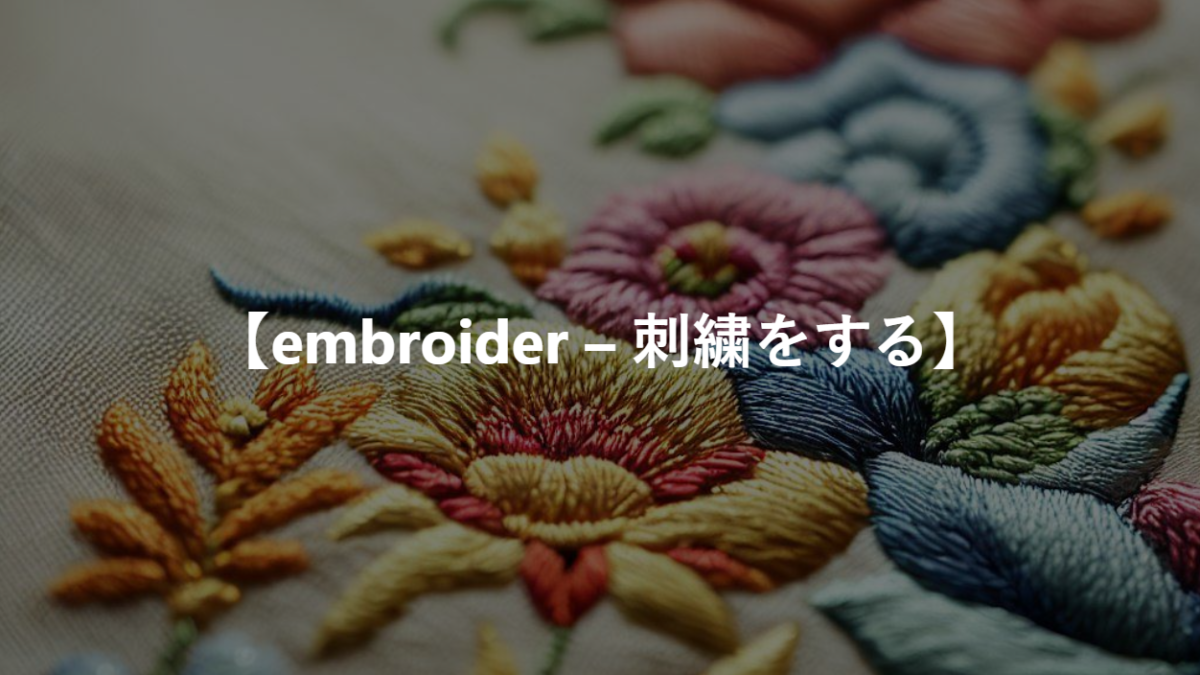語源・類義語・反対語・例文
【Embroider – 刺繍をする】という単語の語源とか由来を知っていますか?
“Embroider”という単語は、中英語の”embroder”から来ており、これはさらに古フランス語の”embrouder”または”embrouer”から派生しています。古フランス語のこれらの単語は、おそらく”en-“(中に、内に)と”broder”(縫う、装飾する)の合成から成り立っています。”broder”はさらに古い語源を持ち、おそらくゲルマン語源であると考えられていますが、その正確な起源は明確ではありません。
この単語の基本的な意味は、布や他の材料に装飾的なデザインを糸で縫いつけることです。時間が経つにつれて、「embroider」は文字通りの意味だけでなく、話や説明に詳細や飾りを加える、つまり話を飾るという比喩的な意味でも使われるようになりました。
The word “embroider” originates from the Middle English “embroder,” which in turn comes from the Old French “embrouder” or “embrouer.” These Old French words likely combine “en-” (meaning “in” or “on”) and “broder” (meaning “to stitch” or “to decorate”). The root “broder” may have an older origin, possibly from Germanic languages, although its exact origins are not clear.
The fundamental meaning of the word is to sew decorative designs onto fabric or other materials. Over time, “embroider” has come to be used not only in the literal sense but also metaphorically, meaning to add details or embellishments to a story or explanation, effectively “embellishing” the narrative.
この単語の類義語・反対語を教えてください。
類義語
- Decorate: 飾る
- Adorn: 飾る、装飾する
- Ornament: 装飾する
- Enhance: 強化する、美しくする
- Beautify: 美しくする
- Garnish: 飾り付ける
反対語
- Plain: 無地の、飾り気のない
- Strip: 取り除く
- Bare: 裸の、無装飾の
- Undecorate: 飾りを取り除く
- Simplify: 単純化する
- Unadorn: 装飾をしない
この単語に似た単語で間違いやすい単語はありますか?
- Embroidery vs. Embroider: 「Embroidery」は名詞で、「刺繍」または「刺繍作品」を意味し、「Embroider」は動詞で、「刺繍をする」という行為を指します。これらは関連は深いですが、品詞が異なるため文脈によって使い分ける必要があります。
- Embroil vs. Embroider: 「Embroil」は全く異なる意味を持ち、「巻き込む」や「紛争に巻き込む」という意味ですが、綴りが似ているために混同されることがあります。
- Enamor vs. Embroider: 「Enamor」は「魅了する」や「恋に落ちる」という意味ですが、”en-“から始まる単語としては間違えやすい可能性があります。
この単語を使った例文を5つほど教えてください。
She carefully embroidered a beautiful floral pattern onto the fabric.
彼女は丁寧に生地に美しい花柄を刺繍しました。
The skilled artisan embroidered intricate designs on the wedding gown.
熟練した職人がウェディングドレスに緻密なデザインを刺繍しました。
I’m learning how to embroider, and I’m currently working on a small handkerchief.
私は刺繍を学んでいて、現在は小さなハンカチを刺繍しています。
She embroidered her initials on the corner of the pillowcase as a personal touch.
彼女は枕カバーの隅に自分のイニシャルを刺繍して、個人的なアクセントを加えました。
The traditional dress was adorned with intricate embroidery, showcasing the rich cultural heritage.
その伝統的な衣装には複雑な刺繍が施され、豊かな文化遺産を示していました。
【embroider – 刺繍をする】のコロケーション
- Embroider a pattern: 模様を刺繍する。特定のデザインやパターンを布や他の素材に刺繍する行為を指します。
- Embroider a dress: ドレスに刺繍をする。ドレスや衣服に装飾的な刺繍を施すことを意味します。
- Embroider with silk: 絹で刺繍をする。絹糸を使用して刺繍を行うことを示します。絹は刺繍において人気のある素材です。
- Hand embroider: 手刺繍をする。機械ではなく、手作業で刺繍を施すことを意味します。手刺繍は伝統的な技法であり、個々の技巧を反映します。
- Embroider a name: 名前を刺繍する。衣服、リネン、バッグなどに個人の名前やイニシャルを刺繍することを指します。
「embroider」という単語は、布や他の素材に糸を使って装飾的なデザインを施す行為を指します。この言葉に関連するいくつかの一般的な使い方、つまりコロケーションには様々なものがあります。
まず、「Embroider a pattern」というフレーズは、特定の模様やデザインを素材に刺繍する行為を表します。これにより、単純な布地が芸術的な作品に変わります。
次に、「Embroider a dress」は、ドレスや他の衣類に刺繍を施すことを意味します。これは衣類に独自性や華やかさを加え、個性を表現する手段となります。
「Embroider with silk」というフレーズは、刺繍に絹糸を使用することを示しており、絹はその光沢と強度で知られています。この方法で作られた刺繍は特に豪華で高級感があります。
「Hand embroider」という表現は、機械ではなく手作業で刺繍を行うことを指し、この伝統的な方法は、作品に個人的なタッチを加えることができます。
最後に、「Embroider a name」というフレーズは、個人の名前やイニシャルをアイテムに刺繍することを意味し、これによってアイテムはより個人的で特別なものになります。
これらのコロケーションを通じて、「embroider」という行為は、単に糸で布を飾る以上のものであることがわかります。それは芸術性、個性、そして手工芸の伝統を反映しているのです。
The term “embroider” refers to the act of adding decorative designs to fabric or other materials using thread. There are various common usages, or collocations, associated with this word.
Firstly, the phrase “Embroider a pattern” denotes the act of applying a specific design or motif onto a material. This transforms a simple piece of fabric into an artistic creation.
Next, “Embroider a dress” means adding embroidery to a dress or other pieces of clothing. This adds uniqueness and elegance, expressing individuality through clothing.
The phrase “Embroider with silk” indicates the use of silk thread in embroidery, known for its sheen and strength. Embroidery created with silk is particularly luxurious and of high quality.
“Hand embroider” refers to the traditional method of embroidering by hand, as opposed to using a machine. This traditional approach allows for a personal touch to be added to the artwork.
Lastly, “Embroider a name” means stitching an individual’s name or initials onto an item, making the item more personal and special.
Through these collocations, the act of “embroidering” is seen as more than just decorating fabric with thread. It reflects artistry, individuality, and the tradition of handcrafting.
文法問題: “embroider” (刺繍をする)
- 動詞の形:
She likes to _________ intricate patterns on her clothes.
(A) embroider
(B) embroidered
(C) embroidering
(D) embroidery
解答と解説: (A) embroider to不定詞の後は動詞の原形が来ます。
– - 目的語との組み合わせ:
The artist _________ a beautiful floral design on the silk scarf.
(A) embroidered
(B) embroidered with
(C) embroidered on
(D) embroidered in
解答と解説: (A) embroidered embroiderは他動詞で、目的語を直接取ります。前置詞は不要です。
– - 名詞形:
The _________ on the traditional costume was exquisite.
(A) embroider
(B) embroidered
(C) embroidering
(D) embroidery
解答と解説: (D) embroidery 空欄には名詞が必要です。embroideryは「刺繍」という意味の名詞です。
– - 類義語:
She _________ the story with colorful details to make it more interesting.
(A) embroidered
(B) embellished
(C) adorned
(D) all of the above
解答と解説: (D) all of the above embroidered, embellished, adornedは、いずれも「飾る」「装飾する」という意味で、この文脈ではすべて適切です。
– - 誤文訂正: The embroideries on the quilt were intricate and colorful.
解答と解説: embroideries → embroidery 刺繍全体を指す場合は、不可算名詞のembroideryを用います。

